- Home
- Tutorial
- Resource Guides
- Focus Areas
- LSF Programs
-
Professional
Development - Review Process
-
A project of LSF

Search for Resources
Description
The purpose of this outdoor activity is to enhance students’ awareness of human activity on biodiversity. The lesson aims to illustrate the differences in plant diversity between natural areas and human-managed areas and have students consider the implications.
Students will engage in a variety of hands-on activities such as:
- comparing the plants in an area managed by humans with the plants in a natural area.
- completing a survey of plants on the school grounds using quadrants.
- learning how to use a field guide to identify plants.
- investigating, comparing and sorting different types of plants
- discussing human management of plant diversity.
- identifying how humans affect plant biodiversity both positively and negatively
The resource includes a detailed description of how to conduct the lesson, guiding questions, curriculum connections, materials needed, a “Teacher Background Information” box , step-by-step instructions for lesson delivery, and guidance on assessment and evaluation.
General Assessment
Recommendation of how and where to use it
This resource provides and excellent activity to enhance the learning by examining the plant life in the school grounds and creating a sample field guide of the different species found there. Students could also brainstorm actions that could be taken to increase the biodiversity on the grounds or in the surrounding community.
Relevant Curriculum Units
The following tool will allow you to explore the relevant curriculum matches for this resource. To start, select a province listed below.
- Step 1Select a province
- Alberta
- Step 2Select a grade level
- Grade 5
- Step 3Select a subject
- Math
- Step 4Relevant matches
- Geometry: Shapes are defined and related by geometric attributes.
- Grade 6
- Step 3Select a subject
- Math
- Step 4Relevant matches
- Statistics: The science of collecting, analyzing, visualizing, and interpreting data can inform understanding and decision making.
- Science
- Step 4Relevant matches
- Living Systems: Understandings of the living world, Earth, and space are deepened through investigating natural systems and their interactions
- Grade 7
- British Columbia
- Step 2Select a grade level
- Grade 3
- Step 3Select a subject
- Science
- Step 4Relevant matches
- Science 3: Living things are diverse, can be grouped, and interact in their ecosystems
- Grade 5
- Step 3Select a subject
- Math
- Step 4Relevant matches
- Closed shapes have area and perimeter that can be described, measured, and compared
- Grade 6
- Step 3Select a subject
- Math
- Step 4Relevant matches
- Data from the results of an experiment can be used to predict the theoretical probability of an event and to compare and interpret
- Manitoba
- New Brunswick
- Newfoundland & Labrador
- Northwest Territories
- Step 2Select a grade level
- Grade 3
- Step 3Select a subject
- Science
- Step 4Relevant matches
- Science 3:Plants and Animals are diverse, can be grouped, and interact in their ecosystems
- Grade 5
- Step 3Select a subject
- Math
- Step 4Relevant matches
- Closed shapes have area and perimeter that can be described, measured, and compared
- Grade 6
- Step 3Select a subject
- Math
- Step 4Relevant matches
- Data from the results of an experiment can be used to predict the theoretical probability of an event and to compare and interpret
- Nova Scotia
- Nunavut
- Ontario
- Step 2Select a grade level
- Grade 5
- Step 3Select a subject
- Math
- Step 4Relevant matches
- Spatial Sense
- Grade 6
- Step 3Select a subject
- Math
- Step 4Relevant matches
- Data
- Spatial Sense
- Science & Technology
- Step 4Relevant matches
- Life Systems: Biodiversity
- Grade 7
- Step 3Select a subject
- Math
- Step 4Relevant matches
- Number
- Spatial Sense
- Science & Technology
- Step 4Relevant matches
- Life Systems: Interactions in the Environment
- Prince Edward Island
- Quebec
- Step 2Select a grade level
- Grade 5
- Step 3Select a subject
- Math
- Step 4Relevant matches
- Measurement: Estimating and Measuring
- Statistics and Probability
- Science & Technology
- Step 4Relevant matches
- Living Things
- Grade 6
- Step 3Select a subject
- Science & Technology
- Step 4Relevant matches
- Living Things
- Grade 7
- Step 3Select a subject
- Science & Technology
- Step 4Relevant matches
- The Living World
- Saskatchewan
- Yukon Territory
- Step 2Select a grade level
- Grade 3
- Step 3Select a subject
- Science
- Step 4Relevant matches
- Science 3: Living things are diverse, can be grouped, and interact in their ecosystems
- Grade 5
- Step 3Select a subject
- Math
- Step 4Relevant matches
- Closed shapes have area and perimeter that can be described, measured, and compared
- Grade 6
- Step 3Select a subject
- Math
- Step 4Relevant matches
- Data from the results of an experiment can be used to predict the theoretical probability of an event and to compare and interpret
Themes Addressed
Ecosystems (2)
- Appreciating the Natural World
- Biodiversity

